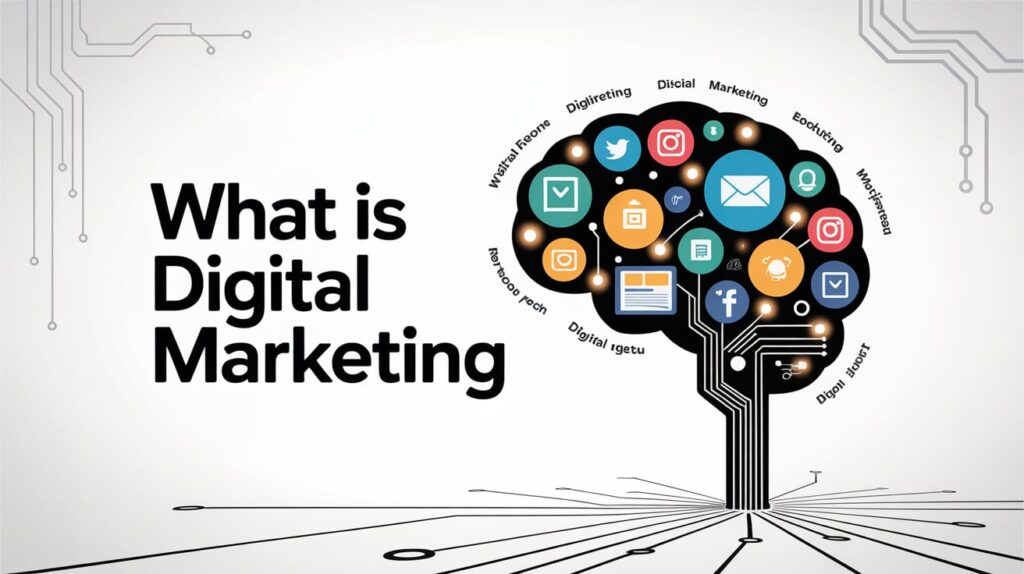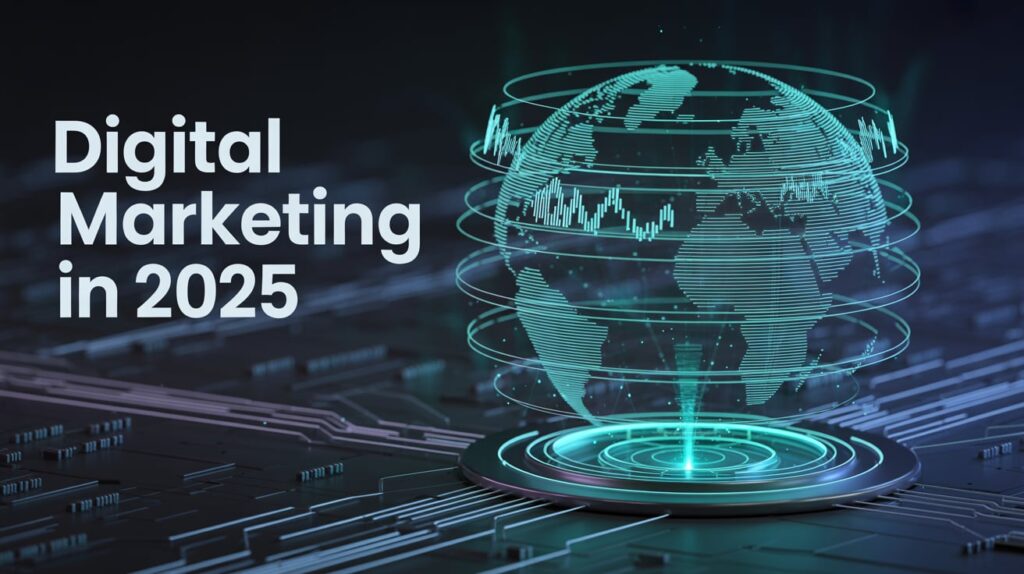In today’s digital-first world, businesses no longer rely solely on billboards, TV ads, or newspaper spreads to reach customers. Instead, they leverage digital marketing—a powerful, data-driven approach to promoting products and services online.
But what exactly is digital marketing, and how does it work? Whether you’re a business owner, marketer, or just curious about the digital landscape, this guide will break down the fundamentals, key strategies, and how businesses use digital channels to drive growth.
1. What Is Digital Marketing?
Digital marketing refers to all marketing efforts that use digital channels—such as search engines, social media, email, and websites—to connect with current and potential customers. Unlike traditional marketing, digital marketing allows for precise targeting, real-time analytics, and cost-effective campaigns.

Why Is Digital Marketing Important?
- Global Reach: Businesses can target audiences worldwide.
- Cost-Effective: More affordable than TV or print ads.
- Measurable Results: Track engagement, conversions, and ROI in real time.
- Personalization: Deliver tailored messages based on user behavior.
ALSO CHECK: What Is Digital Money? A Complete Guide
2. How Does Digital Marketing Work?
Digital marketing works by leveraging multiple online platforms to attract, engage, and convert customers. Here’s a step-by-step breakdown:
Step 1: Define Goals & Target Audience
- Businesses identify their objectives (e.g., brand awareness, sales, leads).
- They research their ideal customers (demographics, interests, online behavior).
Step 2: Choose Digital Marketing Channels
Different platforms serve different purposes:
- Search Engines (SEO & PPC) – Reach people actively searching for products.
- Social Media (Facebook, Instagram, LinkedIn) – Engage with audiences.
- Email Marketing – Nurture leads and retain customers.
- Content Marketing (Blogs, Videos, Infographics) – Educate and attract users.
Step 3: Create & Optimize Content
- Content is tailored to each platform (e.g., short videos for TikTok, long-form blogs for SEO).
- Keywords, hashtags, and CTAs (Call-to-Actions) are optimized for engagement.
Step 4: Launch & Monitor Campaigns
- Ads, posts, and emails are published and promoted.
- Marketers track performance using tools like Google Analytics, Facebook Insights, and HubSpot.
Step 5: Analyze & Improve
- Data reveals what’s working (high click-through rates, conversions).
- Adjustments are made to improve results (A/B testing, budget reallocation).
3. Key Types of Digital Marketing
Digital marketing includes various strategies, each serving a unique purpose:
A. Search Engine Optimization (SEO)
- Improves website visibility on Google and Bing.
- Involves keyword research, on-page SEO, backlinks, and technical SEO.
- Example: A bakery blog post ranking for “best chocolate cake recipe.”
B. Pay-Per-Click Advertising (PPC)
- Businesses pay for ads displayed on search engines (Google Ads) or social media.
- Costs only when users click (CPC – Cost Per Click).
- Example: A shoe brand bidding on the keyword “buy running shoes online.”

C. Social Media Marketing
- Promotes brands on Facebook, Instagram, LinkedIn, TikTok, and X (Twitter).
- Includes organic posts, paid ads, influencer collaborations, and community engagement.
- Example: A fashion brand running Instagram Reels ads targeting millennials.
D. Email Marketing
- Sends personalized emails to subscribers (newsletters, promotions, cart reminders).
- Tools: Mailchimp, Klaviyo, HubSpot.
- Example: Amazon’s “Your cart is waiting!” email with discount offers.
E. Content Marketing
- Provides valuable content (blogs, videos, podcasts) to attract and retain customers.
- Example: A fitness brand publishing workout guides on YouTube.
F. Affiliate Marketing
- Partners (affiliates) promote products and earn commissions on sales.
- Example: A blogger linking to Amazon products and earning a cut.
G. Influencer Marketing
- Brands collaborate with influencers to promote products.
- Example: A skincare company sending free products to a beauty YouTuber.
H. Video Marketing
- Uses YouTube, TikTok, and Instagram Reels for promotions.
- Example: A tech company launching a product demo video.
4. Benefits of Digital Marketing
✅ Wider Reach & Global Audience
- Target customers across countries without physical limitations.
✅ Cost-Effective Compared to Traditional Ads
- Small businesses can compete with giants using low-budget social media ads.
✅ Real-Time Tracking & Analytics
- Instantly measure clicks, conversions, and engagement.
✅ Higher Engagement & Personalization
- AI-driven ads show relevant products based on user behavior.
✅ Better ROI (Return on Investment)
- Optimize campaigns to reduce wasted ad spend.
5. Challenges of Digital Marketing
❌ Constant Algorithm Changes
- Google and Facebook frequently update rules, affecting visibility.
❌ High Competition
- More businesses = harder to stand out.
❌ Ad Fatigue & Banner Blindness
- Users ignore repetitive ads.
❌ Data Privacy Regulations
- GDPR (Europe) and CCPA (California) restrict tracking.
❌ Requires Continuous Learning
- Trends change fast (e.g., TikTok overtaking Facebook).
6. Digital Marketing vs. Traditional Marketing
| Feature | Digital Marketing | Traditional Marketing |
|---|---|---|
| Cost | Affordable (flexible budgets) | Expensive (TV, print ads) |
| Targeting | Precise (age, location, interests) | Broad (mass audiences) |
| Measurability | Real-time analytics | Hard to track (e.g., billboards) |
| Engagement | Interactive (likes, shares, clicks) | One-way communication |
| Speed | Instant results | Slow (weeks/months for impact) |
7. The Future of Digital Marketing
📌 AI & Chatbots
- AI writes ads (ChatGPT), chatbots handle customer queries.
📌 Voice Search & Smart Speakers
- Optimizing for “Hey Google, find a plumber near me.”
📌 Augmented Reality (AR) Ads
- Virtual try-ons (e.g., IKEA’s AR furniture preview).
📌 Privacy-First Marketing
- Less cookie tracking, more first-party data strategies.
📌 Short-Form Video Dominance
- TikTok, Instagram Reels, and YouTube Shorts rule engagement.

8. How to Start with Digital Marketing
- Define Your Goals (Sales? Leads? Brand awareness?)
- Identify Your Audience (Who buys your product?)
- Pick the Right Channels (SEO, social media, email?)
- Create Quality Content (Blogs, videos, ads)
- Track & Optimize (Use Google Analytics, A/B testing)
Conclusion: Digital Marketing Is the Present & Future
Digital marketing is no longer optional—it’s essential for businesses to thrive. By leveraging SEO, social media, email, and paid ads, companies can reach the right audience at the right time with the right message.
The landscape is always evolving, so staying updated with trends and tools is key. Whether you’re a startup or a multinational brand, mastering digital marketing ensures you stay competitive in the online world.
Ready to boost your online presence? Start strategizing today! 🚀


Completely agree with this, appreciate the insight.
Just to add something, I came across a resource recently:
Just putting it here for others.
Great blog! Is your theme custom made or did you download it from somewhere? A design like yours with a few simple tweeks would really make my blog shine. Please let me know where you got your design. Many thanks
no, i did it all by myself
Link yja
MERTYHRTHYHT1106199MARETRYTR
MEYJYTJY2334257MAYTRYR
random browsing session and thought i’d share kind of random,
random browsing session so putting it down basic outline, keeping it here for later. neutral pointe
just clicking around might as well drop this here pretty neutral, keeping it here for later. for context only
Photos for my escort application are uploaded.
Let me know if the quality is good.